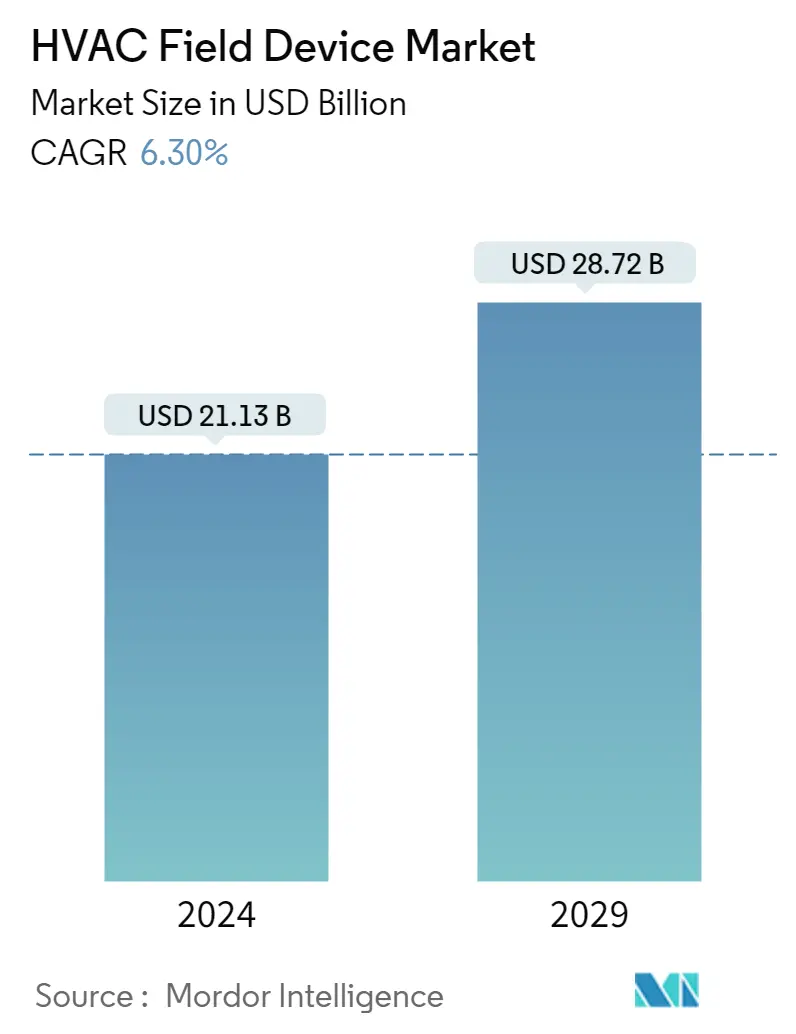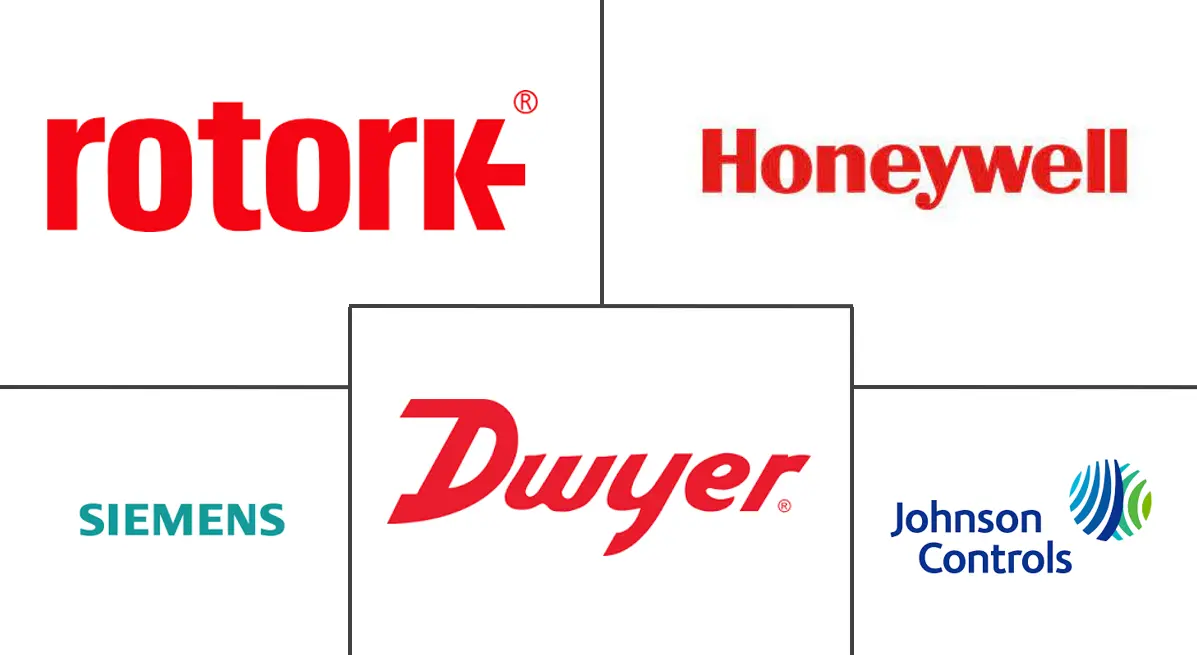Market Size of HVAC Field Device Industry

| Study Period | 2019 - 2029 |
| Market Size (2024) | USD 21.13 Billion |
| Market Size (2029) | USD 28.72 Billion |
| CAGR (2024 - 2029) | 6.30 % |
| Fastest Growing Market | Asia Pacific |
| Largest Market | Asia Pacific |
Major Players
*Disclaimer: Major Players sorted in no particular order |
HVAC Field Device Market Analysis
The HVAC Field Device Market size is estimated at USD 21.13 billion in 2024, and is expected to reach USD 28.72 billion by 2029, growing at a CAGR of 6.30% during the forecast period (2024-2029).
The pandemic significantly influenced the HVAC industry, as demand for the systems observed a significant drop during the initial months, owing to lockdown restrictions and businesses refraining from investing in new equipment. Due to the pandemic, many construction projects were halted across the world. Reduced commercial, residential, and industrial construction activities temporarily dampened the demand for HVAC field devices.
- Consequently, the US government has significantly invested in federal funds that can be used in public buildings, schools, and other settings to improve indoor air quality. For instance, the American Rescue Plan provided USD 350 billion for state and local governments, along with USD 122 billion for schools, that can be used for ventilation and filtration upgrades.
- The end users are adopting smart HVAC equipment to predict when maintenance is needed before a real issue occurs. The latest HVAC technologies, which utilize an Internet of Things (IoT) system, are embedded with sensors, software, and connectivity, enabling the HVAC system to exchange data with other connected devices. IoT systems enhance preventative maintenance by sensing data on air quality and equipment status. Moreover, the latest and most affordable Internet of Things HVAC technology makes it significantly easier to view insights across several equipment types, such as rooftop air-handling units, air- and water-cooled heat pumps, variable air volume (VAV) with reheat systems, etc. These developments in HVAC equipment are expected to further drive the studied market.
- Rising consumer purchasing power coupled with increasing disposable income, especially in developing economies, also positively impacts the market. For instance, according to the National Bureau of Statistics of China, the average disposable income per capita for residents in China was 36,883 yuan, a nominal increase of 5.0% compared to the previous year and an absolute increase of 2.9% after adjusting for inflation in 2022.
- In addition to this, the rising manufacturing sector has further bolstered the scope of HVAC equipment and field devices. According to the World Manufacturing Production Quarter 3 2022 Report by the United Nations Industrial Development Organization, manufacturing production in Asia and Oceania experienced an output growth of 4.4%, ahead of North America (3.5%) and Europe (1.7%). The manufacturing sector in Latin America and the Caribbean expanded by 4.9%, and South Africa grew by 3.0%.
- Furthermore, Eastern Europe has colder climatic conditions, and the demand for heating solutions is significant in these countries, such as the Czech Republic, Poland, Bulgaria, and others. Like other countries in the region, measures to increase energy efficiency in the heating and cooling sectors are rising. The Intelligent Energy Europe Programme of the EU, which co-founded Stratego, claims that an investment of EUR 50 billion between 2010 and 2050 will save enough fuel to lower the costs of the energy system. As part of this investment, district heating's share stood at EUR 5 billion and individual heat pumps at EUR 15 billion.
- Several governments worldwide are offering financial benefits to promote the use of energy-saving equipment in residential and commercial spaces. For instance, the U.S. government introduced the Energy Policy Act of 2005, which provides a tax deduction of up to USD 1.80 per square foot for new commercial buildings. Buildings that reduce their regulated energy consumption by 50% in comparison to the specifications outlined in the American Society of Heating, Refrigerating, and Air-Conditioning Engineers, Inc.'s 2001 new construction standard (ASHRAE 90.1) were eligible for the tax benefit. Government initiatives and rising awareness about environmental degradation and energy management are expected to keep the demand for energy-efficient HVAC control systems, including field devices.
HVAC Field Device Industry Segmentation
Heating, ventilation, and air conditioning (HVAC) use various technologies to control the air temperature, humidity, and purity in an enclosed space. Its goal is to provide thermal comfort and acceptable indoor air quality. HVAC field devices offer a range of precise sensors for temperature, humidity, air quality, and pressure measurement. Further, wireless devices offer significant benefits in terms of ease of installation and cost and also provide flexibility where areas are frequently reconfigured.
The study includes different types, such as control valves, balancing valves, PICV, damper HVAC, damper actuator HVAC, and different sensors like environmental sensors, multi-sensors, air quality sensors, occupancy sensors, and lighting sensors, for different end-user industries, including commercial, residential, and industrial in various geographies. The competitive landscape takes into account multiple companies' market penetration as well as their organic and inorganic growth strategies. The study also considers the market impact of the COVID-19 pandemic. For all of the above segments, market sizes and forecasts are provided in terms of value (USD).
| By Type | |
| Control Valve | |
| Balancing Valve | |
| PICV | |
| Damper HVAC | |
| Damper Actuator HVAC | |
| Other Types |
| By Sensors | |
| Environmental Sensors | |
| Multi Sensors | |
| Air Quality Sensors | |
| Occupancy & Lighting | |
| Other Sensors |
| By End-user Industry | |
| Commercial | |
| Residential | |
| Industrial |
| By Geography | |
| North America | |
| Europe | |
| Asia-Pacific | |
| Latin America | |
| Middle East and Africa |
HVAC Field Device Market Size Summary
The HVAC field device market is poised for significant growth over the forecast period, driven by a combination of technological advancements and increasing demand for energy-efficient solutions. The integration of Internet of Things (IoT) technologies into HVAC systems is a key trend, enabling enhanced predictive maintenance and improved energy management. This shift is supported by rising consumer awareness and government initiatives aimed at promoting energy efficiency and reducing carbon footprints. The market is also benefiting from increased investments in infrastructure and construction, particularly in developing regions, where urbanization and rising disposable incomes are fueling demand for advanced HVAC solutions. Additionally, the focus on improving indoor air quality and the adoption of smart home technologies are further propelling market expansion.
The market landscape is characterized by the presence of several major players who are actively expanding their global footprint through strategic collaborations and product innovations. Companies like Honeywell, Siemens AG, and Johnson Controls are leading the charge with new product offerings that enhance system efficiency and connectivity. The ongoing construction boom in regions such as Asia-Pacific, driven by sustainable building practices and economic growth, is expected to further bolster market demand. Moreover, government policies and financial incentives aimed at encouraging the use of energy-saving equipment are playing a crucial role in shaping market dynamics. As the demand for HVAC systems continues to rise, particularly in residential and commercial sectors, the market is set to experience robust growth in the coming years.
HVAC Field Device Market Size - Table of Contents
-
1. MARKET INSIGHTS
-
1.1 Market Overview
-
1.2 Industry Value Chain Analysis
-
1.3 Industry Attractiveness - Porter's Five Forces Analysis
-
1.3.1 Bargaining Power of Buyers
-
1.3.2 Bargaining Power of Suppliers
-
1.3.3 Threat of New Entrants
-
1.3.4 Threat of Substitute Products
-
1.3.5 Intensity of Competitive Rivalry
-
-
1.4 Assessment of Impact of COVID-19 on the Industry
-
-
2. MARKET SEGMENTATION
-
2.1 By Type
-
2.1.1 Control Valve
-
2.1.2 Balancing Valve
-
2.1.3 PICV
-
2.1.4 Damper HVAC
-
2.1.5 Damper Actuator HVAC
-
2.1.6 Other Types
-
-
2.2 By Sensors
-
2.2.1 Environmental Sensors
-
2.2.2 Multi Sensors
-
2.2.3 Air Quality Sensors
-
2.2.4 Occupancy & Lighting
-
2.2.5 Other Sensors
-
-
2.3 By End-user Industry
-
2.3.1 Commercial
-
2.3.2 Residential
-
2.3.3 Industrial
-
-
2.4 By Geography
-
2.4.1 North America
-
2.4.2 Europe
-
2.4.3 Asia-Pacific
-
2.4.4 Latin America
-
2.4.5 Middle East and Africa
-
-
HVAC Field Device Market Size FAQs
How big is the HVAC Field Device Market?
The HVAC Field Device Market size is expected to reach USD 21.13 billion in 2024 and grow at a CAGR of 6.30% to reach USD 28.72 billion by 2029.
What is the current HVAC Field Device Market size?
In 2024, the HVAC Field Device Market size is expected to reach USD 21.13 billion.

